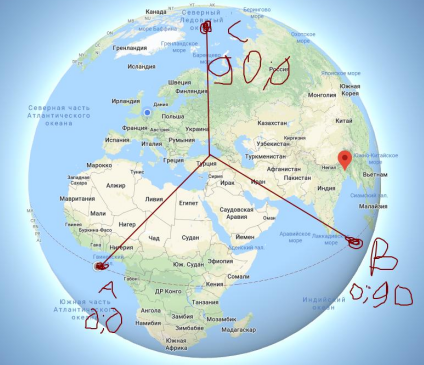search for a point on the map by two coordinates and distances to it
I figured out how to find the distance between two points on the map, but I can't figure out how to solve the inverse problem.
There are three points on the map with known coordinates A (0,0) B (0,90) C (90.0)

And the distances from them to the point D are known, the question is how to find the coordinates of this point. As I understand it, it is enough to solve the spherical triangle ABD, and use the distance C only to determine the pole. But with the calculation of this, there were problems.
UPD brought the problem to the solution of the triangle ABC, following the example https://www.math10.com/ru/vysshaya-matematika/sfericheskii-treugolnik/sfericheskii-treugolnik.html
A(0,0) B(0,90) C(?,?)
AC=8000; AB=10007; BC=4000;
a=1.255; b=1.571; c=0.628;
cos A= (cos a - cos b * cos c)/ sin b * sin c
(0.370-0*0.809)/1*0.587=0.630
I can't find what angle this cosine corresponds to, and how can I get bearing to calculate the coordinates? or did I do something wrong?
1 answers
You know the angular lengths of the sides (distances divided by the radius of the Earth)
Apply the spherical cosine theorem to find the inner angle at A
cos a = cos b ⋅ cos c + sin b ⋅ sin c ⋅ cos A
Hence (using d, not c, since the triangle is ABD)
A = arccos((cos a - cos b ⋅ cos d) / (sin b ⋅ sin d))
для AD=8000; AB=10007; BD=4000;
противолежащая вершине А сторона
a = BD / 6371 = 0.6278
b = AD / 6371 = 1.255
d = AB / 6371 = 1.571
A = arccos((cos a - cos b ⋅ cos d) / (sin b ⋅ sin d)) =
arccos((0.8093 - 0.3106 ⋅ 0) / (0.9505 ⋅ 1)) =
arccos(0.851) = 0.552 радиан = 31.68 градусов
This is the azimuth from point A (in this case, just the azimuth, since A and B are at the equator)
Then use the distance and azimuth (A) to determine the coordinates of D, as shown here in the section Destination point given distance and bearing from start point
φ2 = asin( sin φ1 ⋅ cos δ + cos φ1 ⋅ sin δ ⋅ cos θ )
λ2 = λ1 + atan2( sin θ ⋅ sin δ ⋅ cos φ1, cos δ − sin φ1 ⋅ sin φ2 )
where φ is latitude, λ is longitude, θ is the bearing (clockwise from
north), δ is the angular distance d/R; d being the distance travelled,
R the earth’s radius
Lat = arcsin(sin φ1 ⋅ cos δ + cos φ1 ⋅ sin δ ⋅ cos θ) =
arcsin(0 * cos b + 1 * sin b * sin(0.552)) =
arcsin(0.9505 * 0.524) =
arcsin(0.4984) = 29.9 градусов (СШ или ЮШ)
и далее для Lon
The choice of the hemisphere for D-yes, as already said, by the distance from the pole